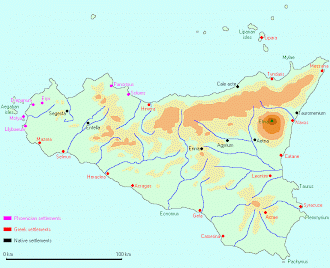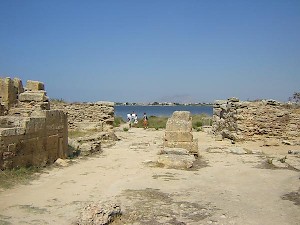Sicily (2)
Q1460Sicily: large and rich island opposite the Italian mainland. In Antiquity, it was settled by Phoenicians and Greeks, and contested by the Carthaginians, Romans, Ostrogoths, and Byzantines.
Colonization

The first settlers after the Sicanians and Siculians were probably Phoenicians arriving in the Early Iron Age, a phase that is sometimes called "pre-colonization". More permanent colonization started in the ninth and eighth centuries and concentrated on the far west of the island, where Motya and Panormus (modern Palermo) were founded. This part was to remain Phoenician for centuries, although the ties with the mother country changed in the early sixth century BCE, when Phoenicia was conquered by the Babylonian king Nebuchadnezzar. The colonies started to look for protection and guidance elsewhere, and became part of the informal empire of the Carthaginians. After all, the distance between Motya and Carthage is only 160 kilometers.
If we are to believe the Greek historian Thucydides,note the first Greeks to appear on the scene were from Chalcis on Euboea. In 734, they settled Naxos, a peninsula near the Etna. In the following year, Syracuse was founded by the Corinthians. Much later, in 580, people from Gela and the isle of Rhodes founded Acragas, which soon became a powerful city under a tyrant named Phalaris.

Originally, the colonies were aristocratic in nature, and it has been argued that one of the causes of the Greek colonization was a desire among the Greek aristocrats to maintain their way of life in an age of change, marked by the rise of nouveaux riches in Greece. However, after some time, the Sicilian towns started to develop along similar lines: a class of nouveaux riches came into being and hoplite warfare became more important. The consequences were identical in the motherland and on Sicily: political tensions and one-man rule by a tyrant. Men like Phalaris and Hippocrates of Gela started to create large territorial states.
At the same time, the Carthaginians understood that their own cities in western Sicily were threatened by the growing Greek towns in the east and south and their energetic inhabitants. The inhabitants of Motya started to build a city wall. During the next centuries, Sicily witnessed two almost perennial struggles: between Carthage and the Greeks, and between one-man rule and other political systems.